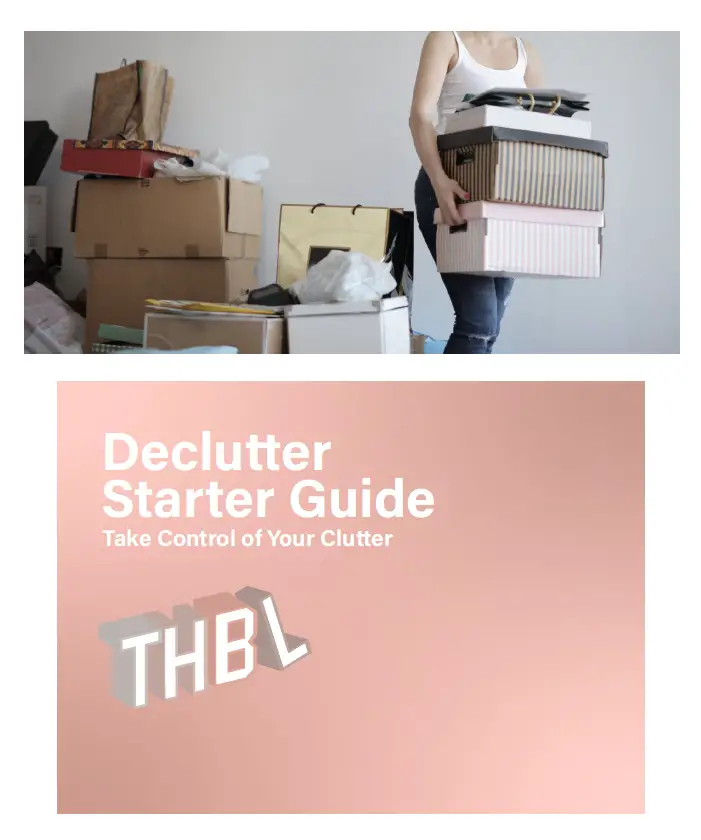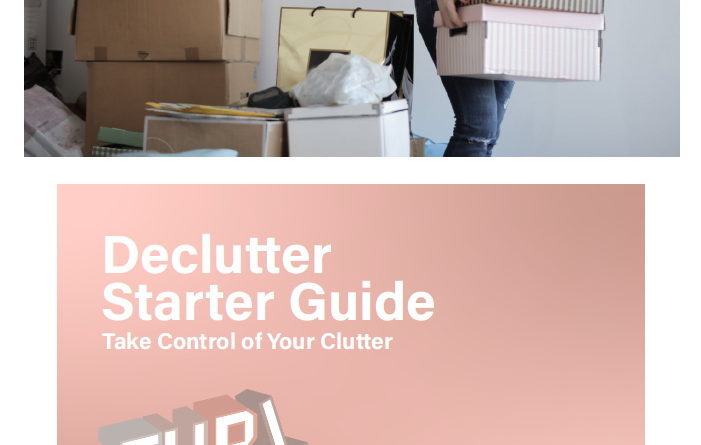How to Begin Decluttering with this Starter Guide

Clutter is a common problem for many of us. And many of us don’t know how to start decluttering.
Perhaps you’ve tried decluttering on several occasions with no success. And feel frustrated, as it seems like you’re stuck in a never-ending cycle of messiness.
Well, the Declutter Starter Guide was developed with you in mind.
There is no one-size-fits-all when it comes to decluttering. Whatever method you use must work for your life.
The simplicity of the Declutter Starter Guide is that it can be customized to suit your needs.
Here’s the link if you haven’t downloaded it yet.
Declutter Starter GuideLet’s dive into how to start decluttering using the Declutter Starter Guide.
What Is Clutter?
When considering how to start decluttering, it’s helpful to give some thought to what constitutes clutter.
Here’s the definition according to Merriam-Webster:
Noun: Things that clutter a place
Verb: To fill or cover with scattered or disordered things that impede movement or impede effectiveness
So, given this information, I’m sure that you can quickly identify a few surfaces and other areas at home that could use some decluttering.
What are the different types of clutter?
Clutter Expert, Karen Kingston outlines that there are four categories of clutter:
- Things you do not use or love
- Things that are untidy or disorganized
- Too many things in too small a space
- Anything unfinished
How to start decluttering
When it comes to decluttering, many of us make the mistake of trying to take on too much at once.
Have you ever set a goal to clear out your entire house in one go, and felt like a failure when you didn’t succeed?
Been there, done that.
And, there is a better way. Start small instead, with just one room or one corner of your house. Or one surface area.
Choose an area where you can see quick results, and when you achieve them give yourself a pat on the back! You’ll have more momentum and be more likely to stick with it if you take things one step at a time.
All you need to get started are some trash bags and containers for what you’ll be keeping and donating – that’s it. As you know, you can find bags pretty much anywhere. For containers, check out the dollar store or keep an eye out for what you already have around your house.
Keep, Trash, Donate
Making these decisions can be challenging and at times, overwhelming, particularly when it comes to sentimental items.
Start with what’s easy. The S.OR.T. Decluttering Process is a simple way of categorizing your items.
Here are a few questions to ask when decluttering:
- Is this item in good working condition?
- Do I use it?
- Do I still like this?
- Is there any strong sentimental value?
- Do I have room for this in my home?
- Nobody is using this, is it in good enough condition to benefit someone else?
- Does this fit?
- Am I going to spend the time and money to repair this?
- How long am I going to keep this outdated, broken item?
Schedule
Here’s the thing, you’ve got to make time to declutter or it’s not going to get done. Once you schedule the time, it gets easier.
So, commit to a date and time. And make yourself accountable by posting it on your calendar or home screen so you can’t ignore it.
Now, you need to get into the zone of an organized mind. The best way I know how is by removing ALL distractions. So, turn off the TV and put your phone on silence (or leave it somewhere far away). Put on some music that’s fun and keep things moving at a good pace. Turn your notifications off so nothing will disturb you while you declutter!
Decide how often and how long your sessions will be based on what makes the most sense for your schedule and how long your attention span is for this process.
Persevere
Now, that you’re underway with decluttering, the key is to stay on track and complete what you started. The best way to stay on task is to set deadlines for how long you’re going to declutter each area, how much you will declutter each day and how often you intend on doing this. This way, you can measure how much progress you’re making, and how far along the road to an uncluttered space you are.
In order to determine how long each day will take, you have to know how much you have in your space. If it is a smaller area with less clutter than bigger spaces, then it should take you less time to declutter. On the other hand, if you are decluttering a larger area, make sure not to set unrealistic goals for how much you’ll do each day. Choose how long your session will take and how often you’ll do these sessions based on how much time you have available.
As previously mentioned, how long you are decluttering each day is up to how long your attention span lasts. Pick how long your session will take based on how much you can handle without getting too overwhelmed with the process. It is also more effective to break down how long it will take into smaller blocks of time because this will stop you from getting burned out at how much there is to do. If you spend too long on just one task, it can feel like an insurmountable goal. It’s also important to take breaks every so often while decluttering. Every half hour or so that you take a short break will give your mind time to absorb everything you have accomplished so far and how much closer you are to being finished.
Mark Task Complete
When you are done you will have the satisfaction of marking your task complete. Get that first checkmark and you will be ready for more!
Now, you’re developing the confidence to branch out and tackle your next task. Celebrate your victories and keep moving.
The Declutter Starter Guide is an effective tool in how to start decluttering and will help you work towards reducing the clutter in your home.
The following simple steps are outlined in the Guide:
- Pick where to start
- Stock up on trash bags
- Schedule the time to declutter
- Persevere with it
- Complete your task
- Branch out and repeat
Implementing these steps in how to start decluttering provides you with a system to finally start getting that clutter under control.
You CAN sort through and pare down your belongings.
Start to create a sense of calm in your home. It’s well worth the journey.
